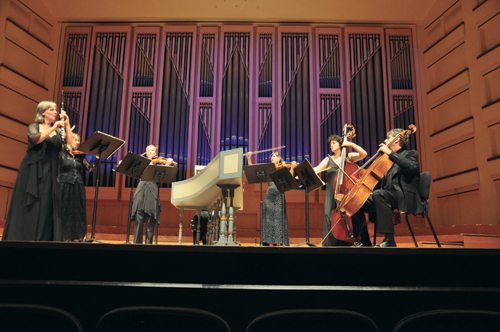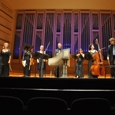
In 1990 The Dorian Consort gave its first concert. The seven member group, consisting of flute, two violins, viola, cello, bass, and harpsichord, has made a niche in the concert scene performing works of the Baroque touring in China, Bolivia, Cuba, the United States, South America, and throughout Europe.
The formation of The Dorian Consort happened by chance. On a summer evening in 1990 I had dinner with a violinist whom I had met ten years earlier in the Swiss Youth Symphony Orchestra and a harpsichord player with whom I had often played in the Swiss town where I was currently living. We shared fond memories, discussed our passion for music, and reflected on the joy of playing together. We wanted to learn more about Bach’s music and share his great cantatas with an audience. I still remember the atmosphere in the garden of the restaurant and the excitement about the future. I have a clear feeling that we left the restaurant content with our plan and a little anxious about realizing the dream of founding an ensemble.
If you are contemplating starting an ensemble, build a wish list early in your musical career noting which repertoire you want to perform, what style period you wish to focus upon, what the instrumentation of the group might be, who you would like to perform with, and the location where you wish to perform.
Set goals according to your situation taking into consideration what is realistic now and what might be right for the future. Discuss whether you should only play concerts, enter competitions, or perhaps acquire more education. Set a time frame based on your goals.
One early decision was what to call the group. While sitting in a coffee shop brainstorming names, we decided to use the term consort rather than ensemble since we wanted to focus on playing Baroque music. We tried many words with consort and eventually chose the combination Dorian Consort, in part because the last name of our first violinist is Dora. Another member liked the film The Portrait of Dorian Gray, and we all liked the idea of the Dorian mode.
In our case we decided to do what we liked most with musicians we liked most. The three of us took a risk and invited four musicians to join us for a day of rehearsals. When we all met, everything clicked. As we developed ideas about how to go forward, an immediate priority was rehearsal time. In the summer 1991 the seven of us stayed for a week in a village in Austria. We rehearsed for hours every day. The plan for the group was to play on modern instruments but get as close as possible to an authentic interpretation and also to play without a conductor. This was revolutionary for the time. Without a conductor, everybody needed to know the score. In rehearsals we experimented with different concepts and learned to communicate and trust each other to lead and follow.
After this week of intense work and discussion, The Dorian Consort played its first concert the next December. We performed in a beautiful church where the harpsichord player was a church organist. We had a wonderful and large audience. It was such a pleasure to play with these talented musicians and friends who had so much fun being on stage and in performance together. The concert was a great success.
The Dorian Consort decided that for this first year, we would invest in the ensemble and only get paid for expenses. If we continued in the future, we would develop a board of directors. Other topics of discussion included the group’s organizational structure, whether we should have a manager, and producing a CD.
It was a big surprise when we got two sponsors after the first concert. One helped us to pay for basic organizational needs. From this sponsorship we were able to order a portfolio with a fantastic graphic artist.
The other sponsor hired us for private concerts in 1992-1993. Our harpsichordist was especially talented in talking to sponsors. We started applying for grants and looked for performances on established concert series. We continued The Dorian Consort summer rehearsal week for many years.
For a while we had a secretary/manager, but it never worked to our satisfaction, so we split the organizational work between the members of the group. Everyone had to take some responsibility. The tasks at hand were librarian, travel agent, grant writer, treasurer, archivist, scheduler, and coordinator.
I do not remember how many crises we had in the 20 years of our existence, and many times we debated whether we were able to go on or wanted to. We always were able to discuss matters, work through through the challenges, and in the end grow closer together and play better.
In 1999 we started travelling abroad with two new members in the group. We went to the US and China. It made us rethink our goals and we decided to travel to the more undeveloped countries to help them build their music programs at schools and their classical music scene.
The Dorian Consort has performed many times in South America and later in China. We started to play contemporary Swiss music for cultural exchange. We often performed for audiences who were unfamiliar with Baroque music but were hungry to hear whatever we played. Attending a concert was something very special for many of them, and that made it a wonderful experience for us as well.
I encourage everybody to follow the idea of doing the things you like, and the things you are passionate about. Take the risk and follow your vision and dreams. Whether your ensemble is successful or not, you will gain important insights and experience. It does not matter to us where we play because no matter where we are, the great pleasure is that we did it together as the family we are.
We feel like a team – like one instrument. We play together as an ensemble simply because we love to make music together. This shapes all our decisions, and also affects our sound and music making.
* * *
Tales from the Road
Cuba
We were performing the Bach Suite No. 2 in B minor at a music school when the lights shut down. We continued playing, finishing the movement. While we were waiting in the dark, one of the violinists played a movement of solo Bach. Still there was no light. Then we heard a guitar playing from the audience. It was a wonderful unforgettable moment as we sat in the dark and experienced this musical dialogue between the stage and the audience.
Bolivia
In Sucre, Bolivia we went to the church where we would be performing and found that the organ was in the pitch of A=415 which is a half-step lower than A=440. Our harpsichordist transposed the entire program (including the Bach Musical Offering) a half-step higher and the instrumentalists tuned down as far as possible. You can imagine how we concentrated during the concert, which went wonderfully.
The Dorian Consort toured Bolivia many times playing concerts in La Paz, the capitol, which has an altitude of 13,300 feet. It takes a while to adjust to this altitude, so we learned to ask for a bottle of oxygen at the airport. As we drove to the hotel, each of us breathed oxygen for ten minutes. I also kept a bottle of oxygen at my bedside. One concert program featured the Bach Suite No. 2 in B minor, the Bach Brandenburg Concerto No. 5, and some solo Swiss contemporary flute pieces. The concert promoter encouraged me to take oxygen before playing and in between the pieces. I did and playing was never so easy. However, the next day I paid for it with a terrible migraine. Since then I play concerts without the aid of an oxygen bottle.
China
In 2000 The Dorian Consort was invited to perform in China, a time when there was not much classical music there yet. This meant that we had to bring our own harpsichord that we would leave at the end of the trip for use by musicians there. Traveling with a harpsichord was difficult. The instrument was packed in a wooden box and was supposed to be handled as oversized luggage. As we were waiting at baggage claim to pick up our luggage in Shanghai, we noticed the harpsichord on the baggage carousel. We raced over to rescue it because if it was damaged, our tour would have been impossible.
Another time we arrived extra early at the airport to check the harpsichord, but the airline told us they would not take the harpsichord. What the travel agent did to get them to accept the harpsichord, we do not know, but the harpsichord arrived on time for the next concert.
Selected Repertoire with Flute
Antonio Vivaldi (1678-1767),
“la notte” for Soloflöte, Strings and Basso Continuo
“il cardellino” for Soloflöte, Strings and Basso Continuo
Georg Philipp Telemann (1681-1767)
“Tafelmusik 1” Suite for 2 Flutes, Strings and Basso Continuo
Suite a-moll für Flöte, Strings and Basso Continuo
Johann Sebastian Bach (1685-1750)
Triple Concerto in A-Minor BWV 1044 for Flute, Violin, harpsichord and strings
Brandenburg Concerto No. 4 in G-dur BWV 1049 für Violino 2 Flutes, Strings and Basso Continuo
Brandenburg Concerto No. 5 in D-dur BWV 1050 für Flute, Violin, harpsichord and strings
Concerto in F-Major BWV 1057 for 2 Flutes, Strings and Basso Continuo
Suite No.2 in B-Minor BWV 1067 for Flute, Strings and Basso Continuo
“The Musical Offering” BWV 1079
“Ricercar a sei” from “Musical Offering” BWV 1079
Triosonata in C-Minor from “Musical Offering” BWV 1079 for Flute, Violin and Basso Continuo
Art of Fugue BWV 10
Kantate No. 82a “Ich habe genug” for Soprano, Flute, Strings and Basso Continuo
Kantate No. 209 “Non sà che sia dolore” for Soprano, Flute, Strings and Basso Continuo
St Johns Passion BWV 245; 2 Fl., 2 Ob., 1 Bassoon., Strings, B. C., Chor (8), Evangelist
Mass in A-Major BWV 234; Fl, Strings , B.C., Chor (8)
Johann Joachim Quantz (1697-1773)
Concerto in G-Major for Flute, for Strings and Basso Continuo
Carl Philipp Emanuel Bach (1714-1788)
Trio sonata in C-Major for Flute, Violin and Basso Continuo
Concerto in A-MajorW. 168 for Flute, Strings and Basso Continuo
Concerto in D-Minor W. 426 for Flute, Strings and Basso Continuo
Luigi Boccherini (1743-1805)
Quintett in F-dur (Februar 17787) for Flute, Violin, Viola, Cello and Contrabass
Wolfgang Amadeus Mozart (1756-1791)
Quartett in D-Major KV 285 for Flute, Violin, Viola and Cello
Frank Martin (1890-1974)
“Sonata da Chiesa” (1938) for flute and strings






